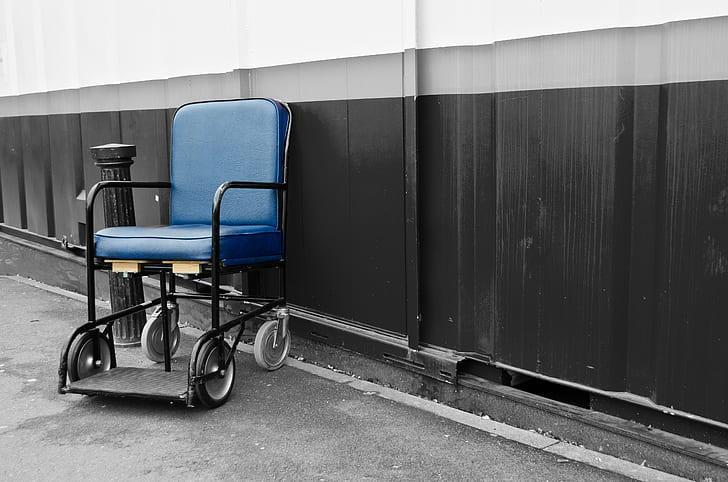The Social Security Administration (SSA) offers two programs aimed at providing financial assistance to people with disabilities. These programs are called Social Security Disability Insurance (SSDI) and Supplemental Security Income (SSI). But what are the differences between both programs?
The main difference is that the criteria for SSDI require work history, work credits and a listed disability versus SSI criteria requires individuals to fall under a particular income and asset limit.
Read below as we explain these differences in more detail.
SSI Overview
Supplemental Security Income is a tax-funded program that offers financial assistance to disabled, elderly, or visually impaired people who have little or no income. Income is the determining factor in eligibility for SSI benefits. Your previous employment is not relevant.
It might be difficult to determine if your income is low enough to qualify for SSI because not all income counts toward the limit.
In general, you are qualified for assistance if your annual income is equal to or less than the monthly Federal Benefit Rate (FBR), which in 2023 is $914 for individuals and $1,371 for couples. In addition, you need to have less than $2,000 in countable assets (or $3,000 if you are a couple) in order to be eligible for this program.
Applying for Supplemental Security Income is not as simple as it seems.
You will need your Social Security Number (SSN), the name and contact information of your physician, details about any medications you take and the results of any medical tests, as well as your most recent W-2 form. If you are married, you will also be required to provide documentation of your marriage.
SSDI Overview
Social Security Disability Insurance is a federal program that offers financial support to disabled or blind workers who have paid into the Social Security system sufficiently to be eligible for benefits. You must have a specific number of years of work experience, the exact number of which depends on your age, in order to be eligible.
Workers who are younger than 24 years old are required to have contributed to the program for a minimum of 1.5 years in the three years leading up to the disability.
For workers above the age of 30, you must have worked five out of the last ten years. If you are between the ages of 24 and 30, you’re required to have worked no less than fifty percent of the period between your 21st birthday and the quarter at which you became disabled.
The Social Security Administration considers not only your most recent employment history but also your whole working career when determining whether or not you are eligible for benefits. The minimum amount of total contribution time required ranges from 1.5 to 9.5 years, depending on your age.
Even if you are able to work despite your disability, you could still qualify for Social Security Disability Insurance.
Your income must be less than the program’s maximum after deducting any costs related to your disability. This limitation can also be referred to as the threshold for Substantial Gainful Activity (SGA). The monthly SGA limit in 2023 is $1,470 for disabled applicants and $2,460 for blind applicants.
Eligibility
The eligibility requirements for both programs differ greatly.
SSI
Anyone is free to apply for Supplemental Security Income. To qualify for Supplemental Security Income you must be a citizen of the United States who is either blind, disabled, or elderly and who also meets the following criteria:
- has a low income
- has limited financial resources
- is a legal resident of the United States or a qualifying resident alien
- lives in any of the 50 states, the District of Columbia, or the Northern Mariana Islands as their primary residence
- does not go abroad over a period of 30 days or more
- is not under the care of a formal institution
- fits a number of other criteria
SSI is a program that determines eligibility based on a person’s income and resources. Both your income and your assets must be below a certain threshold.
To be eligible for Supplemental Security Income beginning in 2023, a person’s total financial assets must amount to no more than $2,000. However, this limit does not apply to all of your assets, such as your main place of residence or your primary vehicle.
If you apply for Supplemental Security Income, the Social Security Administration will utilize a complicated calculation to evaluate whether or not you are eligible for the program based on your income. If your monthly income is $914 or less in 2023, you may be able to qualify for the program.
SSDI
In order to be eligible for this program, you need to have worked for a sufficient amount of time and within the most recent time period to be regarded as “insured.”
There is a correlation between your age and the minimum number of years of work experience required; as you get older, the minimum number of years of experience required to qualify increases.
SSDI benefits are based on a person’s Social Security Disability credit history. When you pay taxes into the Social Security system, you are awarded credits. You can earn up to four credits per year based on your total Social Security tax contributions.
To be eligible for Social Security Disability Insurance, you must:
- be unable to engage in gainful employment as a result of a medical condition that is expected to continue for a minimum of 12 months or result in death
- qualify as disabled according to Social Security rules
- be under the age of full retirement age
Benefit Amount

The amount of money that SSA Disability vs SSI benefits offer is very different from one another.
SSI
The federal SSI payout amount for a person in 2023 is $914 per month. (Most states provide a supplementary payout on top of this.) The federal SSI payout amount for couples in 2023 is $1,371 per month.
SSDI
Monthly SSDI payments in 2023 average $1,483. This represents an increase from the monthly rate of $1,358 in 2022. Because Social Security Disability Insurance payments are based on prior employment history, some SSDI recipients may be eligible for a higher sum.
The maximum amount that a beneficiary of SSDI is eligible to receive each month is $3,627.
Funding
Both SSI and SSDI have different sources of funding.
SSI
SSI comes from the federal government’s general revenue. Even though the Social Security Administration is in charge of running the program, its funding does not come from the Social Security system. In addition to federal aid, many states also provide their own, state-funded aid to their residents.
SSDI
Payroll taxes for Social Security are the primary source of funding for SSDI. An SSDI tax of 0.9% is deducted from employees’ and employers’ incomes, respectively, up to the maximum amount that can be taxed by Social Security.
Regulations
There are different regulations governing both programs.
SSI
Since SSI is a means-tested benefit, changes in a recipient’s financial situation may have an impact on their eligibility and the amount of financial assistance they receive. You are obligated to notify Social Security of any changes in your current or future financial situation, including the following:
- A promotion or raise in salary
- Having a relative move-in
- Marriage
If you marry someone who is receiving SSI benefits, your payments may drop because the maximum benefit for a couple is less than the sum of two individuals’ benefits. Advocates for people with disabilities often refer to this loss in benefits as the “marriage penalty.”
But let’s say your partner isn’t an SSI recipient. In that scenario, Social Security will take the individual’s income into account when deciding whether or not you are qualified for benefits.
SSDI
The Social Security Disability Insurance program is not based on income or assets, but you could lose your benefits if you make too much money. If you continue to work while receiving SSDI, you are required to report your income to the Social Security Administration.
You may qualify for Social Security Disability Insurance even if you have no history of employment, provided you meet the following requirements:
- You are a disabled widow, widower, or surviving divorced spouse who is between the ages of 50 and 60. You must have a disability that started before or within seven years of the death of your spouse.
- You are an adult who was diagnosed with a disability before you turned 22 years old. The earnings record of one or both of your parents can be used to determine whether or not you are eligible for Social Security benefits.
Healthcare

Beneficiaries of both programs are entitled to different types of healthcare benefits.
SSI
If you are receiving income from SSI, it is likely that you qualify for Medicaid without a waiting period. In many states, those who receive SSI are eligible for Medicaid without having to apply for it on their own.
SSDI
Individuals under the age of 65 who are receiving SSDI payments are automatically enrolled in Medicare. However, before they become eligible for Medicare, most SSDI beneficiaries must wait 24 months following the start of their disability benefits. Those who suffer from amyotrophic lateral sclerosis (ALS) or a kidney disease that has progressed to the end stage are exempt from this waiting time.
Can I Get Both SSI and SSDI?
It is possible for a person to be eligible for both SSDI and SSI in certain circumstances.
Having said that, the benefits do not combine; instead, you will receive the maximum amount that each benefit offers separately. In most cases, an individual’s Social Security Disability Insurance payout amount for the month is higher than $914 if they have insured status. In such a case, the recipient will only get their SSDI benefit.
It is possible for someone’s Social Security Disability Insurance benefit amount to be lower than the amount of SSI benefit money if they have an insured status but a less stable job history. Such an individual will first get their SSDI benefit, after which they are going to get an additional SSI benefit for the amount that is equal to the difference between their SSDI benefit and the predetermined amount for SSI.
If a person’s Social Security Disability Insurance benefit is $500, for instance, the individual will get $500 in SSDI along with up to $414 in SSI, for an overall payment of $914 (the predetermined amount for SSI).
There are additional changes in the calculation of backpay based on whether an individual is qualified for Social Security Disability Insurance, Supplemental Security Income, or both.
Is it Harder to Get SSDI or SSI?

The majority of those who have been through the process will agree that applying for SSDI is the more challenging of the two.
It is true that there is a high denial rate for SSDI because the Social Security Administration uses a narrow definition of disabled, and the applicant must produce considerable medical proof to verify they fulfill this definition in order to qualify for benefits.
But what do the statistics say about approval rates? The approval rate for Social Security Disability Insurance is 51%, whereas the approval rate for Supplemental Security Income is only 36%. This suggests that it is much more difficult to get approved for SSI vs SSDI.
Overall, Social Security benefits are hard to obtain.
Only 34% of people who apply for Social Security Disability are granted benefits after their initial application. Working with a disability advocate will make sure that your application contains all of the essential information, which will help increase the likelihood that your claim will be approved.
Conclusion
In conclusion, although both SSI and SSDI are managed by the SSA and aim to provide financial assistance to people with disabilities, there are some major differences between the two programs, especially with regards to their eligibility requirements. It is always helpful to seek the help of a disability advocate or to consult a disability attorney to find out which program you might qualify for.


